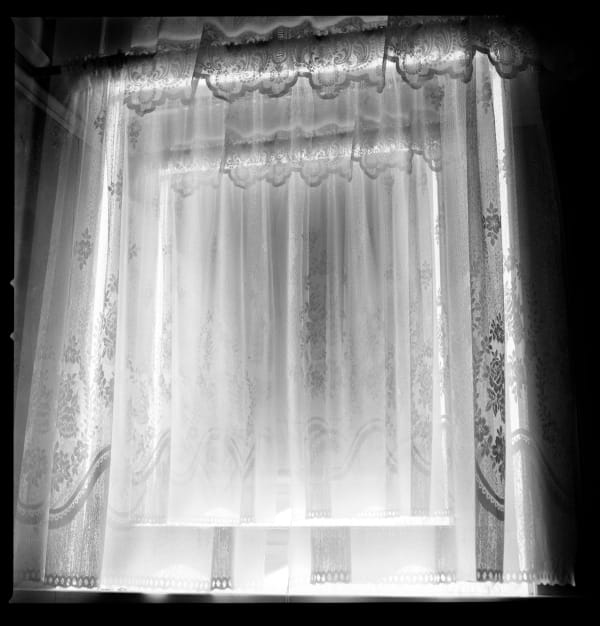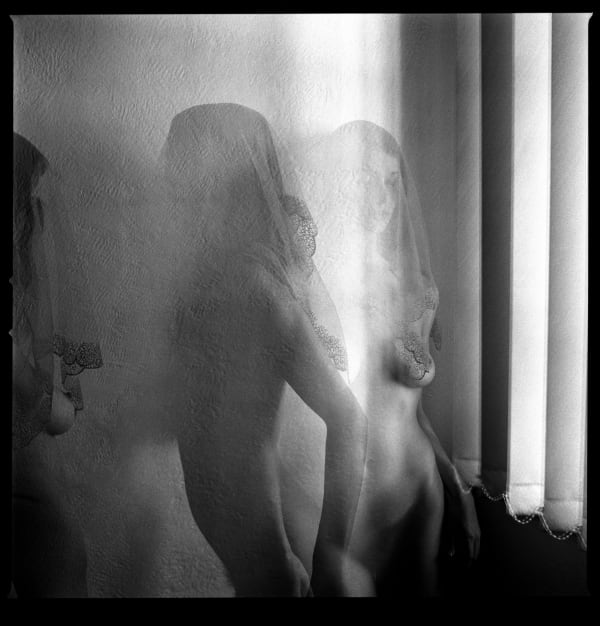Jane Burton: A Phantom Lover
‘The magic of photography was what drew me to it in the first place:
the interval between what you see through the lens - the limbo in
wait of alchemical transformation- and the revelation of the
photographic print.’
Advancing. Turning. Retreating. A spectral figure manifests from a patch of light on a roughcast wall. Part vapour, part flesh, the soft territory of a body starts to apparate with womanly volumes and a girlish face, and she is gone before she fully arrives. Light and shadow. Light and shadow.
She is a collection of concavities and convexities. The cutaway of her waist, the languor of her wrist, and even the tiny curvature of her inner elbow—these are the fragmentary details of a delectable erotic repertoire. Her light skin is veiled in a gossamer mantilla. Her eyes are modestly downcast but, the dark nipple that nudges the border of her veil is hard and pert: Light-and-shadow-light-and-shadow.
And now we can almost see the rotating figure of a girl as she flickers through a sequence of dappled, semi-naked moments of self-regard. In this dance, the mood oscillates between youthful innocence and prosaic fetishism. It’s charming and vaguely pornographic—but in some way troubling.
Her hand in a long glove intersects the shady planes of inner and outer thighs, the satin compares to the skin of a pale belly. The young woman’s loosed hair, the yielding flesh of her breasts, the angle of her shoulder, and the tilt of her nose—these captured glimpses supply more than sufficient information to provoke voyeuristic attentiveness, but far less than enough to construct an imagined persona. In the fragmentary language of fetishism, she is simply she. Shadow, light, shadow.
Implicated within the play of planes and surfaces, there’s a striped background that’s deeply satisfying in terms of pure formal composition. Its disciplined tonal gradations provide a linear counterpoint to the womanly curves and the straight and sinuous lines are deliciously interspersed. The stripes provide a rhythmic backdrop, a reminder of Alexander Rodchenko’s Lestnitsa (Stairs), of 1929. Against these strict lines the figure unfurls her limbs and performs her pirouettes—or so we are permitted to imagine. Altogether, the verticals syncopate the figure’s captured poses, amounting to something like a jump-cut effect that implies movement between points of time.
Veils. Modesty. Exposure and concealment. Arousal. Whispers. Murmurings. Sighs. Here we occupy an atmosphere in which it is difficult to construct a complete sentence. Yet, as I say, there is a formal logic, even a jumpy syntax of sorts, which oscillates between coherence and incoherence, order and confusion, and of course the pure contrast of dark and light that’s the very nature of black and white photography.
Jane Burton has been operating in this complicated realm of pleasure and fantasy, with a measure of realism, for nearly thirty years, in a pursuit of the photographic medium that tilts between narrative and abstraction, and veers between romanticism and violence. In the current body of work, the same tensions arise, due to the strange equivalence that has been struck between the figurative and non-figurative elements, in a marriage of opposites.
Though it operates partly as a stylistic abstraction, we can plainly see that the pleasing, striped ‘Constructivist’ arrangement in some of the photographs is nothing other than an undisguised set of ordinary vertical blinds, connected by scalloped strings of tiny baubles. We know what they’re like: they’re synthetic, institutional and nasty to the touch; they are devoid of sensuality. Only as an exercise in photographic formalism are they are inscribed with aesthetic pleasure. As objects in the world they offer a practical solution with no joy, but to a photographer they offer an opportunity to exploit a type of “camera seeing.” Throughout Europe in the 1920’s and ’30’s, photographic vision was exalted as a special form of vision: The New Vision, as Moholy-Nagy called it and, in his view, this mechanical vision was something like a correction or significant augmentation of the limits, the inherent weakness, of the human eye. The poetics of the New Vision was that of keen mechanical observation and careful exploitation of black and white contrast and finitudes of tonal variation; literally, light and shadow.
Which would be all very well, if only the world presented everything to vision. However, as we know, there are other shadows.
If for a moment we ignore the pleasure of the symmetry and order of the linear shadings, and focus on the practical-yet-tawdry suburban blinds, we sense the bathos of someone young playing dress ups, a lone figure with long satin gloves, with their fetishistic and masturbatory implications, trying on an old code of sexual symbolism. Shadows deepen.
Extending from the lower edge of the drearily familiar blind, there’s a glimpse of the gloved hand, outstretched this time. Logically, we deduce that we are seeing the hand of the same photographic subject, repeated. But here, as it gropes from the lower edge of the blind, it seems that the right hand doesn’t know what the left hand is doing. Literal logic and pure visual evidence are displaced and, somehow, in conjunction with the edge of the nasty blind, this beckoning gloved hand is off-putting, even threatening.
The foreboding is confirmed in another sighting of the spectral hand, upturned this time. It seems to cup a shadowy head—alas, poor Yorick. The claw-like hand in the ruched, satin of the glove gives the hand of a young girl the concentration of a memento mori, and the wrinkled glove seems to prefigure the withering and stiffening of her own body.
Photography has, since its inception, also permitted an inner vision, fully supplemented by the imagination, the mind’s eye. In the English-speaking world, the Surrealists’ exploitation of the supplementary power of the photographic medium were roundly explored by theorists like Rosalind Krauss and Hal Foster in the 1980’s and 90’s, by drawing upon Freudian and Lacanian conceptions of the unconscious. Jane Burton continues to mark out territory in this field, time and again throwing up what Krauss once referred to as a “vexing question of style”, because there is no formulation that can easily define what constitutes surrealism, except perhaps a determination to chase the contents of the unconscious: Shadow.
All this now. So many shadows. At this point in time, the singularity of the figure, enclosed in a room with drawn blinds, coincides with the self-isolation of so many people over the globe, in situations where some are separated from their friends, family and lovers while others are entrapped with theirs, such that phantoms are duplicating logarithmically like the virus.
But in all of this ruin there is a mysterious promise of redemption, a turn inward, a need for deep introspection and recalibration. The formal play of Jane Burton’s suite of images wildly exceeds the mildly pornographic effects of their figurative elements; it signifies a larger and much more mysterious force: the chatter of suburban voodoo in the quiet rattle of the blinds, the almost imperceptible whispered prayers of sundrenched nylon lace curtains which radiate unaccountable grace and exaltation, and possibilities for recuperation and fulfillment. Light, from Shadow.
Maria Kunda April 2020
Thanks to Dr. Mary Knights for her helpful comments on the essay
-
 Jane BurtonA Phantom Lover #1, 2020pigment print120 x 115cmEdition of 5 plus 1 Artist ProofAU$ 5,200.00 + framing
Jane BurtonA Phantom Lover #1, 2020pigment print120 x 115cmEdition of 5 plus 1 Artist ProofAU$ 5,200.00 + framing -
 Jane BurtonA Phantom Lover #2, 2020pigment print120 x 115cmEdition of 5 plus 1 Artist ProofAU$ 5,200.00 + framing
Jane BurtonA Phantom Lover #2, 2020pigment print120 x 115cmEdition of 5 plus 1 Artist ProofAU$ 5,200.00 + framing -
 Jane BurtonA Phantom Lover #3, 2020pigment print120 x 115cmEdition of 5 plus 1 Artist ProofAU$ 5,200.00 + framing
Jane BurtonA Phantom Lover #3, 2020pigment print120 x 115cmEdition of 5 plus 1 Artist ProofAU$ 5,200.00 + framing -
 Jane BurtonA Phantom Lover #4, 2020pigment print120 x 115cmEdition of 5 plus 1 Artist ProofAU$ 5,200.00 + framing
Jane BurtonA Phantom Lover #4, 2020pigment print120 x 115cmEdition of 5 plus 1 Artist ProofAU$ 5,200.00 + framing -
 Jane BurtonA Phantom Lover #5, 2020pigment print120 x 115cmEdition of 5 plus 1 Artist ProofAU$ 5,200.00 + framing
Jane BurtonA Phantom Lover #5, 2020pigment print120 x 115cmEdition of 5 plus 1 Artist ProofAU$ 5,200.00 + framing






